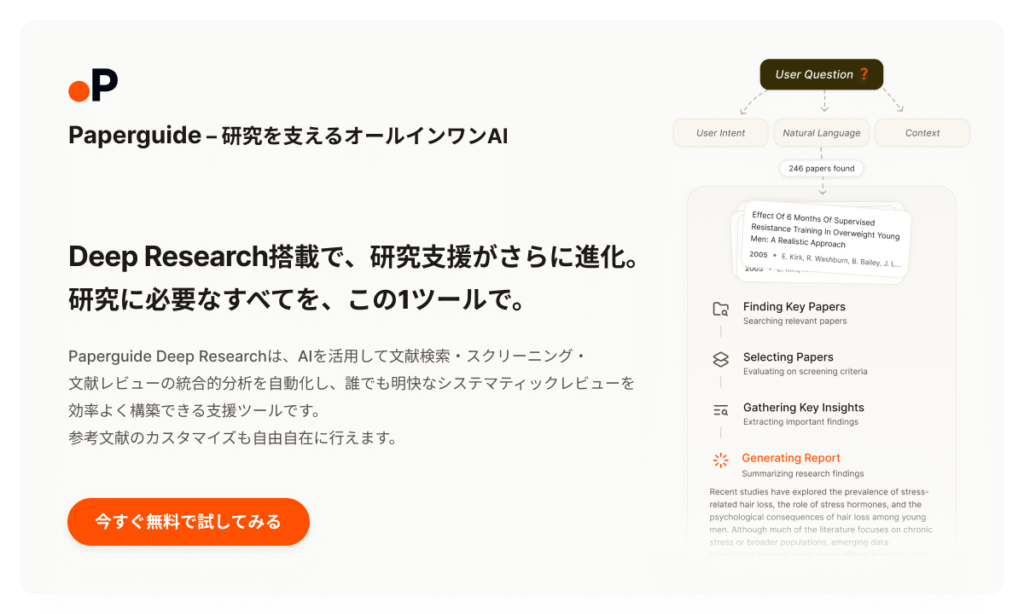“Searching” determines the outcome of research
This is true.
Immediately after deciding on a research topic and planning a research project, the waiting ...
 Akanon
AkanonA vast sea of papers
I couldn't find the paper I wanted fast enough."
When did you spend so much time searching for papers?
I'm worried I'm missing a citation..."
This article is designed to address these concerns.How to search for papers using AI."to the following.
The tools we present here are,SciSpace、Paperguide、Elicit、consensus、Connected papers。
- Easily communicates the intent of the search
- Easy to find the paper you want
- Eliminates the need to read the paper abstract every time.
- Eliminates concerns about citation leaks.
The time it takes to search for articles is dramatically reduced, and the accuracy of the search is clearly improved.
 Akanon
AkanonNo reason not to use it.
How to Use AI Paper Search Tools
 Akanon
AkanonThe author is an active researcher with over 10 years of research experience.
I use the AI tools in the following ways
- Daily paper searchTo:SciSpace, Paperguide
- When you want to find quality papers for important occasionsTo:Elicit, consensus
- Deep dive into related papersWhen you want to:Connected papers
New tools are being added all the time, but these four are the ones I use most often at the moment.
 Akanon
AkanonObviously, it's a lot easier to search for papers now!
Let me quickly introduce my search method.
SciSpace for routine article searches

Why do you routinelySciSpaceIf you are using a...,
Not only the literature search, but even the reading support is superb.
The flow of "find a paper -> read the paper you found" is most convenient.
Moreover, many features are included for researchers to use on a daily basis, such as library and writing functions.
 Akanon
AkanonThere's only one reason you'd want to use it.
What can you do with SciSpace's literature search?
- Enter a Question in sentence form
- A summary with citations is displayed for the Question
- of each paper.Considerations and results are displayed in a list
- In-depth questions can be asked for each paper.
- Deep Review for even more powerful article searching
Search for papers by Question
As soon as possible, go to the top page of SciSpace and type in the Question you want to search.

How effective is radiation therapy for patients with early-stage (stage I or II) lung cancer compared to surgery or chemotherapy?"
Such a cursory Q&A is sufficient.
Of course, Japanese is fine.
 Akanon
AkanonIt's very easy to just put the keywords you want to include in the text.
The output display is tabled.
Now, let's look at the actual output.
The following is the output screen.
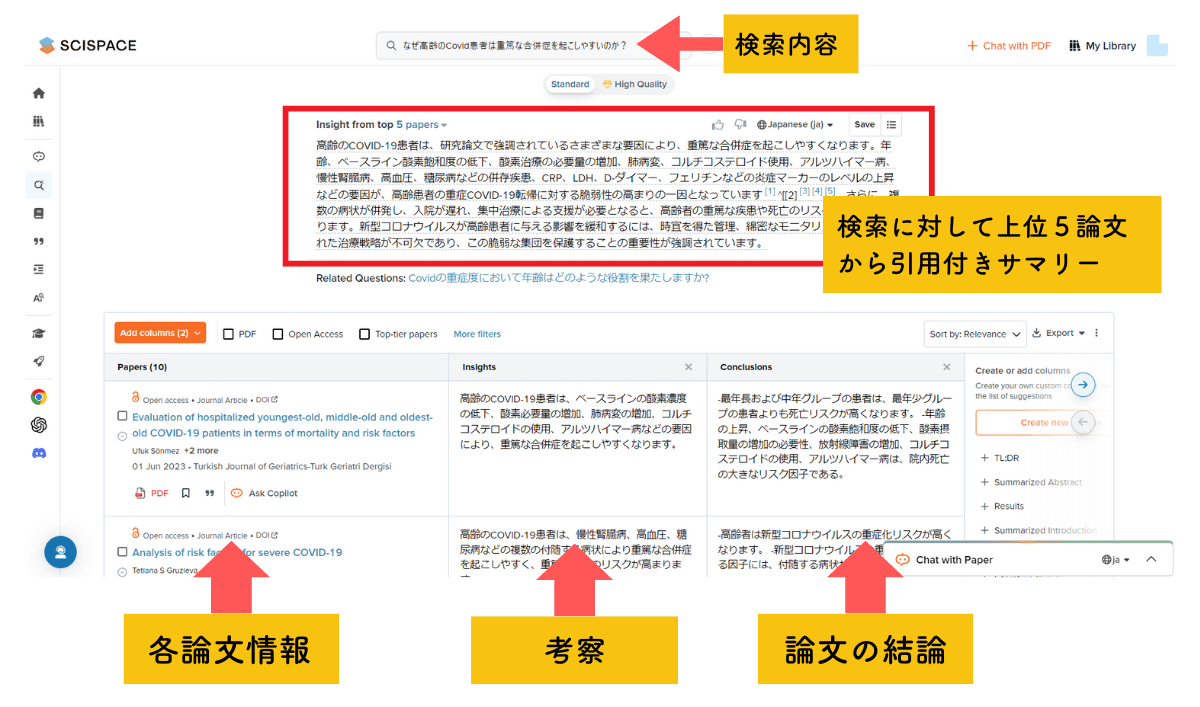
At the top of the output screen is a summary with quotes ↓.
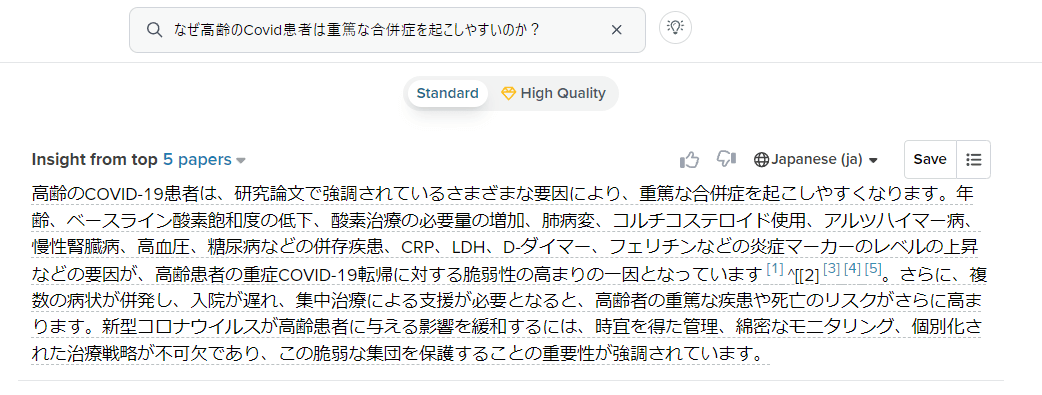
A list of information, discussion, and conclusions for each paper at the bottom of the output screen ↓.
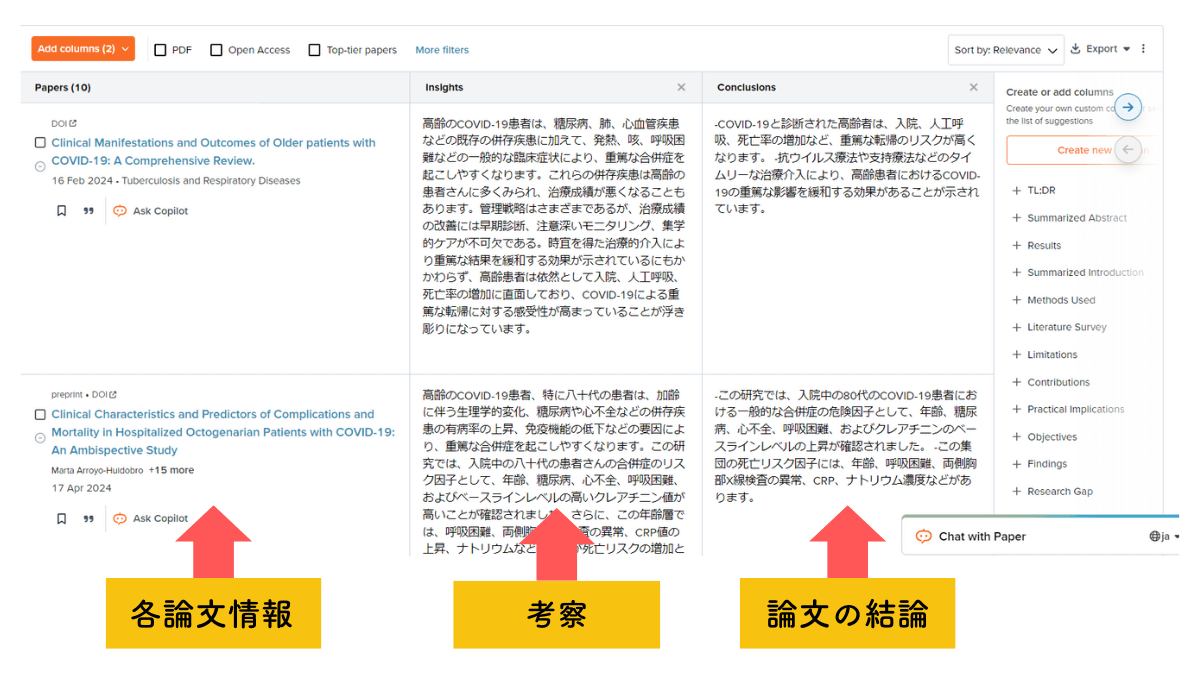
Not only basic information about each paper, but also its contents and discussion are tabulated.
In addition, everything has been translated into Japanese!
This much output in less than 30 seconds. Amazing speed...
SciSpaceAccording to him, he has picked up references from more than 200 million literature databases.
Tabling of outputs can be edited.
For added convenience, table entries are selective and can be edited as desired.
 Akanon
AkanonFor example, you can add "experimental methods" or "limitations of the study"...
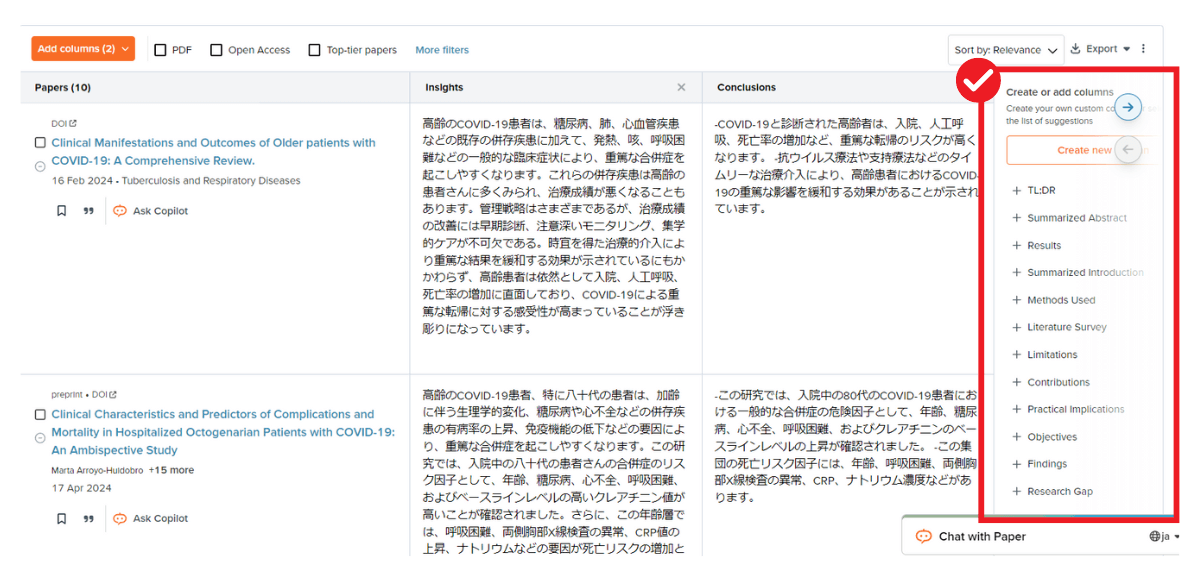
How convenient... (Impressive)
Furthermore, if you are curious about the details of a particular paper, you can ask questions individually with AI.

Just like the old days,
I went to the literature page and read the abstract... "This is something different! (discouraged)."
This eliminates any waste of time.
 Akanon
AkanonThank you... (crying)
Organize your papers in the library
Next,
Papers of interest found in the literature search areSciSpacelibrary.
Once registered in the library, you can read the articles at any time using SciSpace's reading support features.
Below is a screen shot of the library.
Each item (editable), such as results and methods, as well as article information, is tabulated.
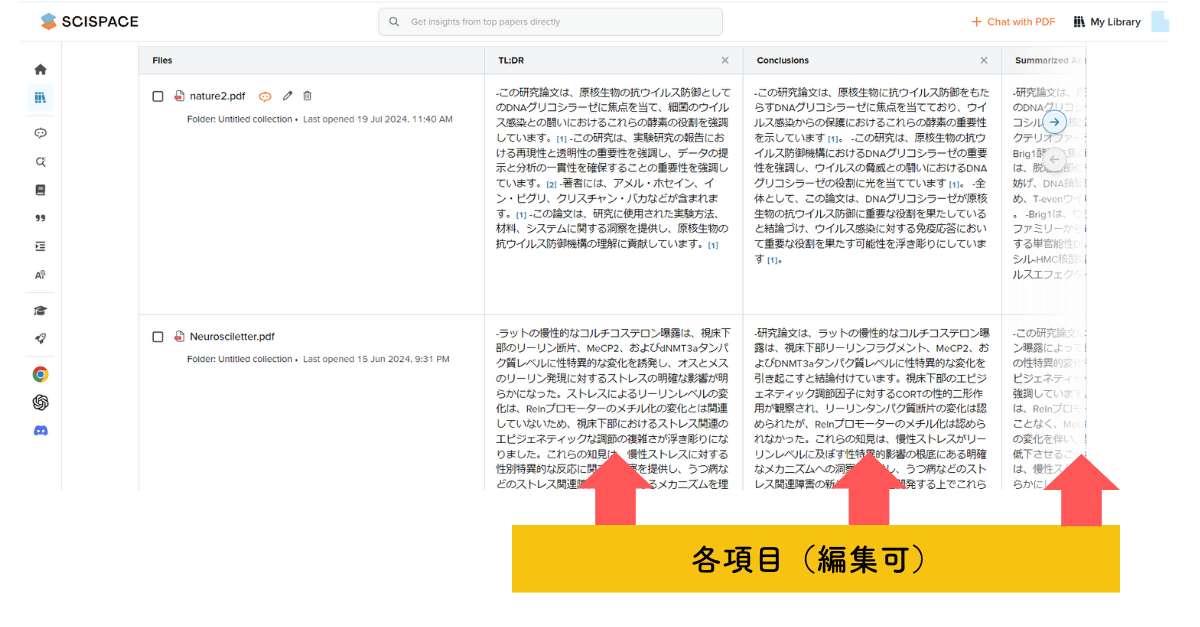
Even if you only look at the literature titles listed in literature management software, etc,
What's this paper about?"(I do). (I do.)
It would be very useful to have a list like this.
In addition, SciSpace's "Reading Support" allows you to read through even the most difficult papers at ultra-fast speeds.
And, well, it goes like this.SciSpaceis a highly recommended tool, but I'm sorry about one thing.
You can use the free version, though,If you use it, you should get the paid version.It is a tool that is
 Akanon
AkanonI also use it for a fee!
The reason for this is that the free version has inferior quality AI for all functions.
However, with a coupon, you can use the paid version for only about 1,000 yen/month.
- For Annual Plan (40% OFF): ACADEMIA
- For monthly plans (20% off): ACADEMIA20
Deep Review has a separate pricing plan and exclusive coupons. Please see the following explanatory article.
Deep Review for even more powerful article searching
SciSpace is constantly evolving, and a new article search feature, Deep Review, was added in February 2025.
You can search with even greater precision by using Deep Review.
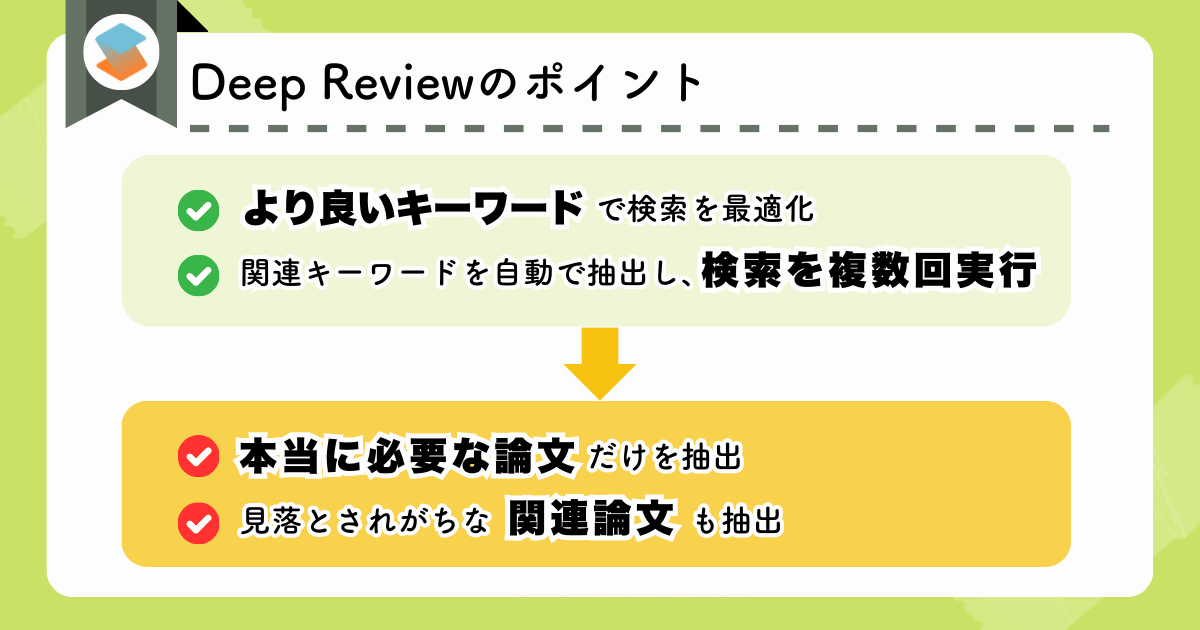
- Better keywords?
-
Before performing a search,Chat with us to dig deeper into search intent and optimize search keywords
- Automatically extract relevant keywords and perform multiple searches?
-
Automatic extraction of related keywords。
With the respective keywords,Multiple Searchesto make your search results better.
Better KeywordsThe AI will chat with you to dig deeper into your Qustion to extract the
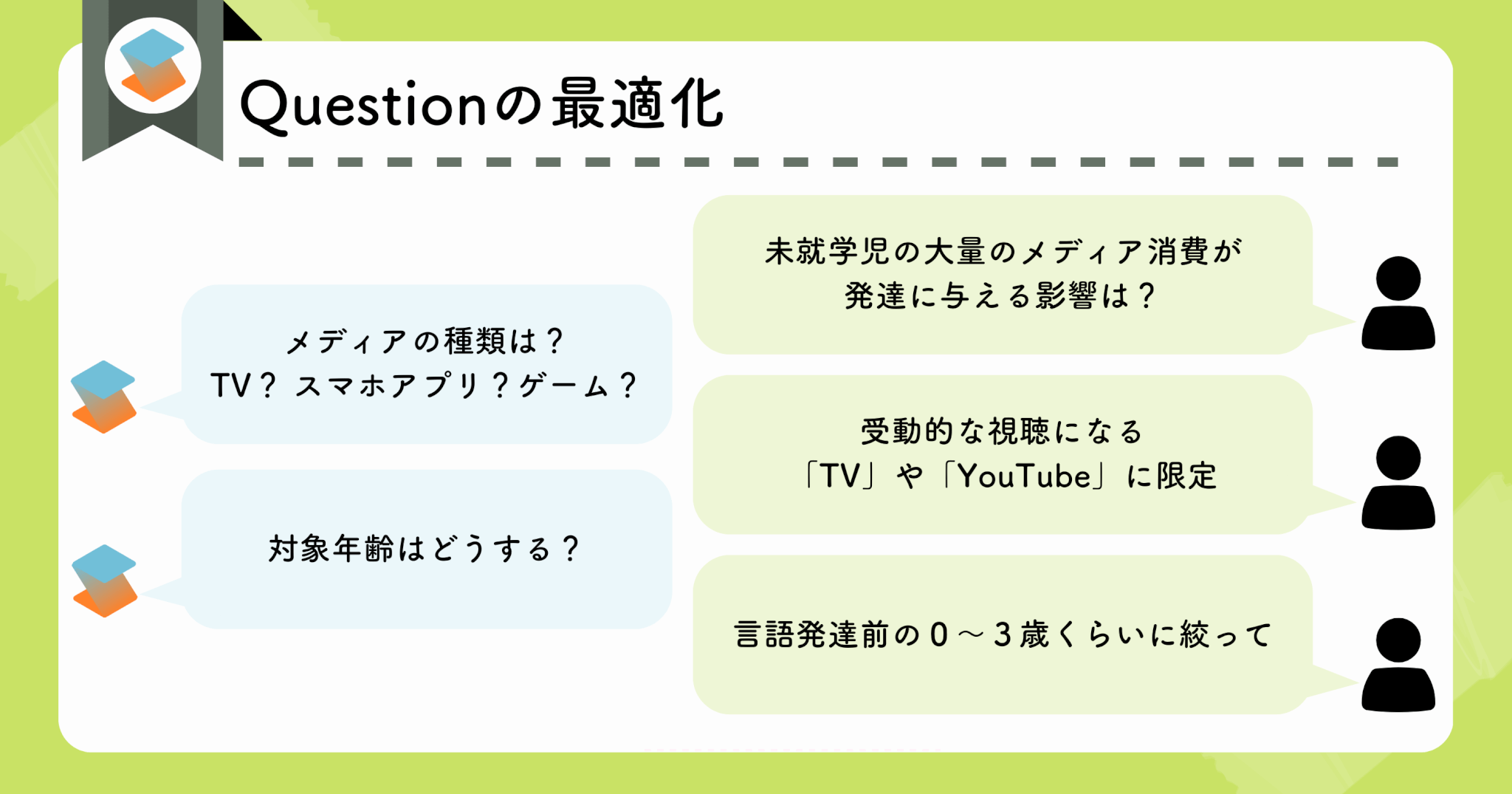
Sometimes, AI will ask you a question and you will realize a condition that you have not thought this far.
In addition, it is done automatically by AI."Extract more relevant keywords to broaden your search."
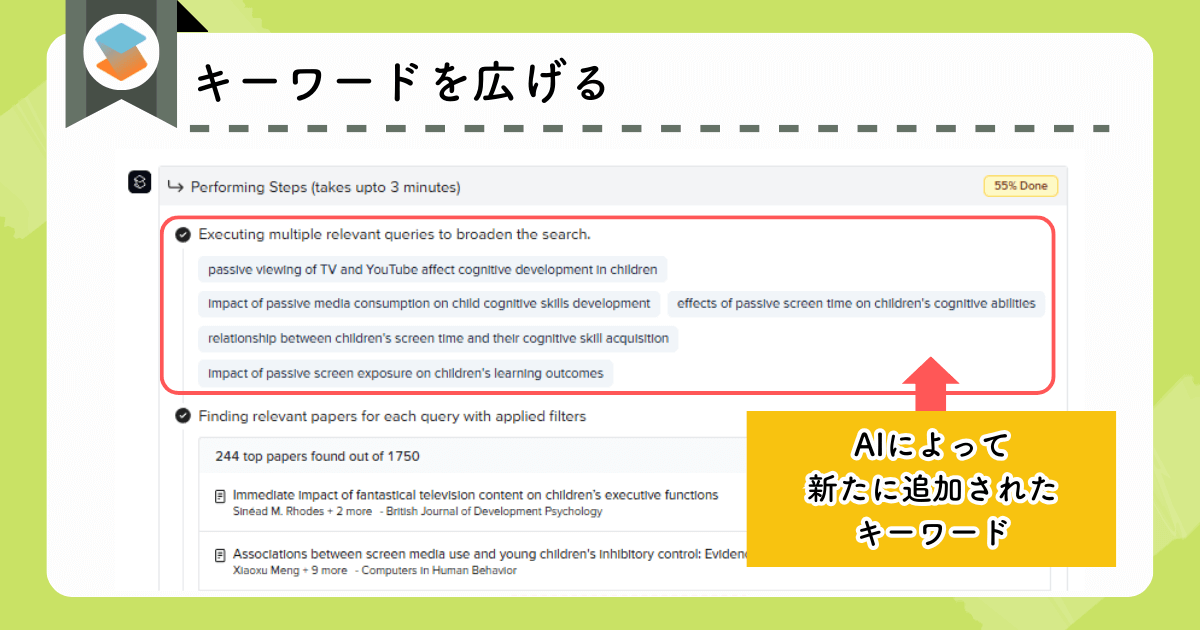
Perform multiple searches for each newly added keyword.
 Akanon
AkanonPrevents search omissions due to differences in wording
Thus...
- Search Keyword Optimization
- Automatic conversion of search keywords to perform multiple searches simultaneously
With the addition of these two points,Unparalleled search accuracyDeep Review was the first to do so.
It is only available with the Advanced plan, which is the highest level of SciSpace.
For more information about Deep Review, including examples of outputs and plans, see anotherexplanatory articleWritten in.
Other features include writing support (AI writers and citations), reading support, podcasts, and many more features of SciSpace.
 Akanon
AkanonIt is truly a researcher's all-in-one tool!
Please read the explanatory article as well.
For more information.
Official SiteSciSpace (https://typeset.io/)
SciSpace.explanatory article:Why use SciSpace? Detailed explanation of 5 functions and fee plans
SciSpace "Deep Review".explanatory article:SciSpace's "Deep Review" Dramatically Improves the Accuracy of Article Searches
Paperguide is also recommended for routine article searches

A tool that has been rapidly gaining market share recently is thePaperguideIt is.
Considerably more than SciSpace.low priceto use almost the same functionality.
 Akanon
AkanonDeep Research is also coming in 2025/6 for even better performance.
The focus on AI writers also differentiates us from SciSpace!
 Akanon
AkanonAs for comfort of useSciSpaceIt is very similar to
Paperguide offers three types of article searches
| AI Search | Literature Review | Deep Research |
|---|---|---|
| For an overview | When you want to find a paper | When you want to find a paper and create a detailed review based on the paper |
Deep Research first optimizes the keywords in the chat.
(This is the same as SciSpace.)
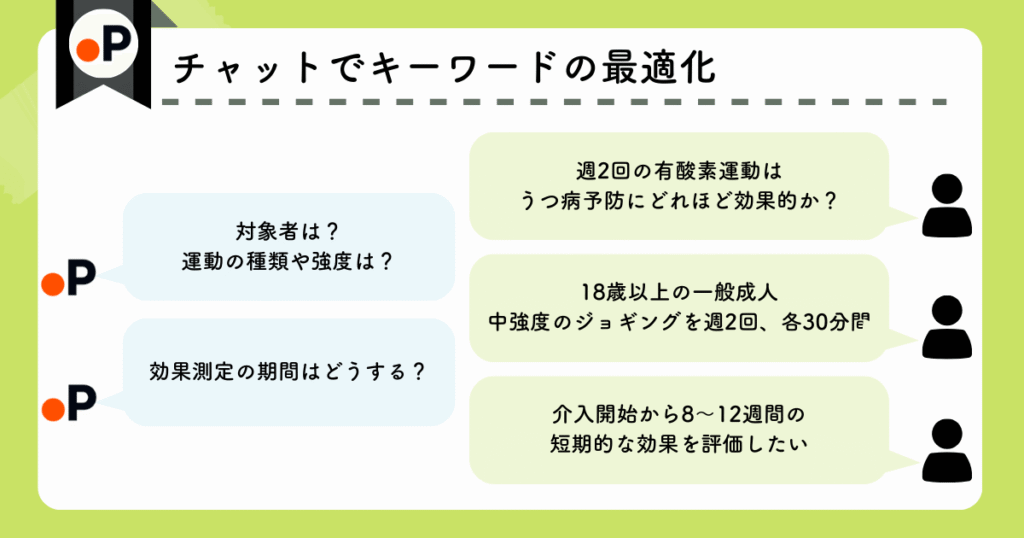
After the chat, the research questions are pretty well formulated.
| Before | After (AI generated by chat) |
|---|---|
| How effective is aerobic exercise twice a week in preventing depression? | Moderate jogging in adults 18 years of age and oldertwice a week.(30 minutes per session)To be implemented,Depression based on self-administered depressive symptom scores (e.g., PHQ-9)How effective is it in prevention?(Randomized controlled trials will be the main focus, but observational studies will also be included.) |
In addition, Paperguide,There is a Controlled Deep Research mode that allows the user to add, modify, and delete the following points。
- Sub-questions (questions to broaden your search)
- Screening points for papers
- Paper to be selected
 Akanon
AkanonSo the user can intervene quite a bit to create a review, which is different from SciSpace's Deep Review!
A 👇 detailed review will be completed.
Deep Research is available on Paperguide even with a free plan.
This is a method of upgrading plans when you want to use more than the limited number of times.
Limit the number of times Deep Research
- Free plan: Up to 2 times
- Plus plan: up to 10 times
- Pro Plan: up to 50 times
Compare the price with SciSpace,
| SciSpace (Advanced Plan) | Paperguide (Free to Pro Plan) |
|---|---|
| 42 USD/month (After using our 40% discount coupon) | 0 yen to $24/month |
Moreover, Paperguide has a student discount, which is 40% off the above prices.
 Akanon
AkanonCospa seems to be by far the best.
It is easy to use to search for articles other than Deep Research.
For Research Question,AI Search for an overview。

For Research Question,Literature Review is the place to find articles.。
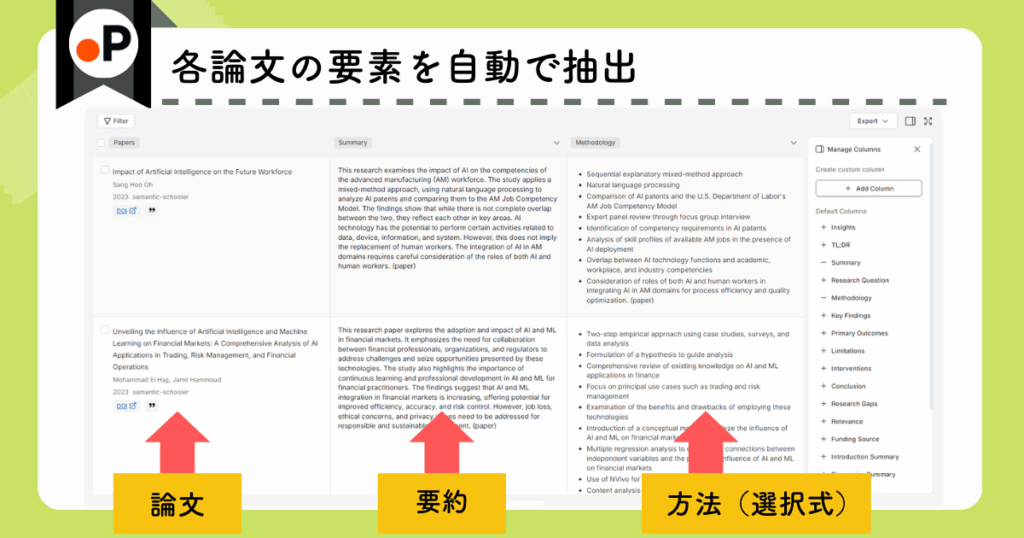
 Akanon
AkanonIt can be used depending on the situation at the time.
Other all-in-one tools such as writing support (AI writers and citations), reading support, and library functions position SciSpace as a competitor.
Please also see Paperguide's commentary article.
For more information.
Official Site:Paperguide (https://paperguide.ai/)
explanatory article:What are Paperguide's features and fees? An active researcher explains an AI tool that streamlines paper writing
Elicit to find comprehensive papers

ElicitはComprehensive literature searchI recommend it above all when you want to
Elicit's amazing features are...
- Classification of Concepts
- Extracting data from papers and turning them into tables
- Highly complete systematic reviews can be created automatically.
Exhaustive search by concept classification
First, let us elaborate on the concept classification.
When to use concept classification...
- When writing a review article or systematic review
- When you want to develop a new field
「I want to understand certain keywords in an exhaustive manner.」This is very useful to prevent information leakage.
First, enter keywords in the "list of concepts" search window.
For example, search for the big word "back pain".
(Other methods such as "treatment of ________" or "mechanism of ________" are also acceptable)
Then, the definition of "back pain" that exists in the literature database is summarized,Specific pathologies."The system subdivides the data by category (see figure below).

It also provides an overview with citations that summarizes the top papers for each of the concepts.
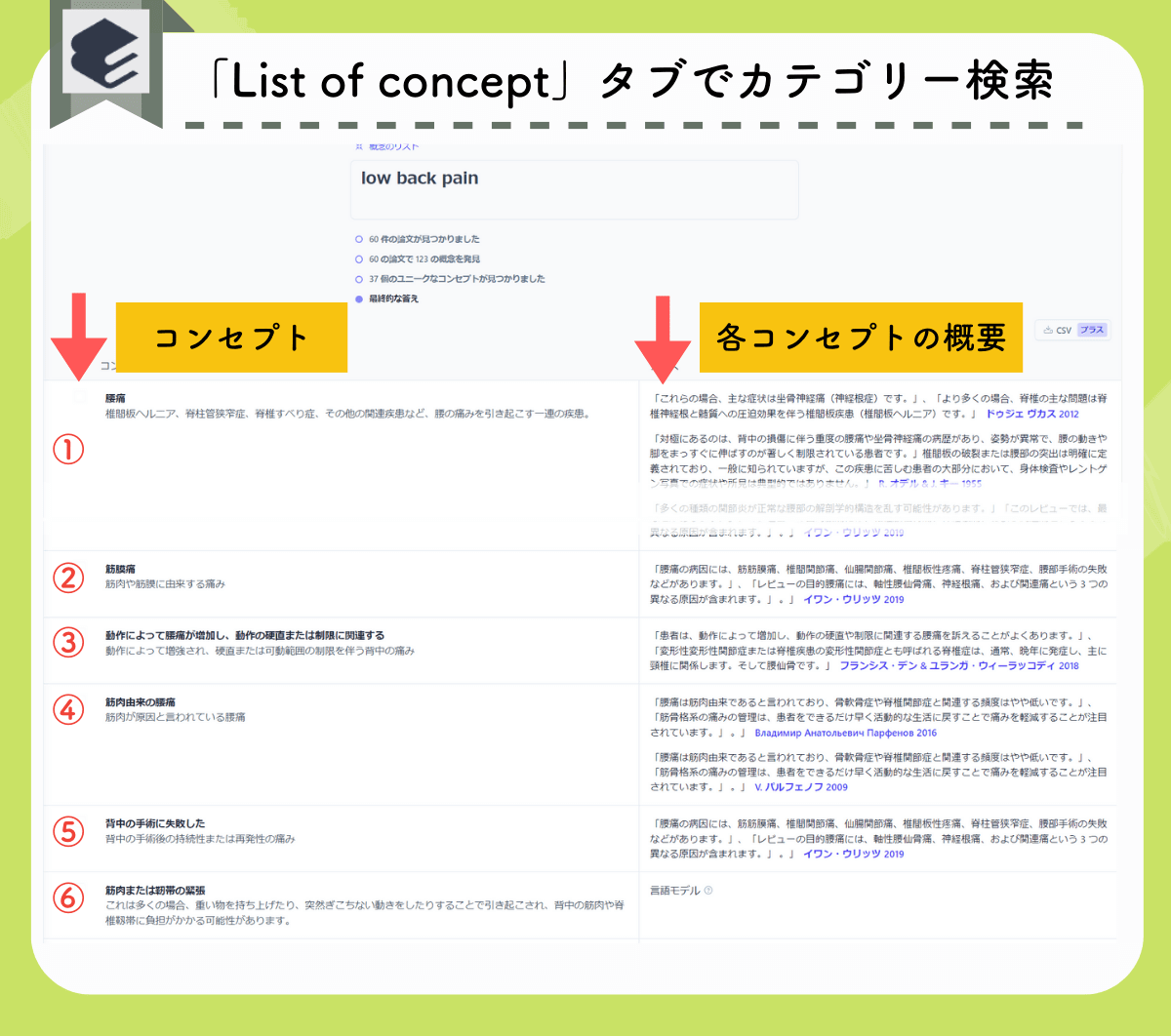
The table of outputs is easy to read.
The search results screen for papers is also tableized and very easy to read.
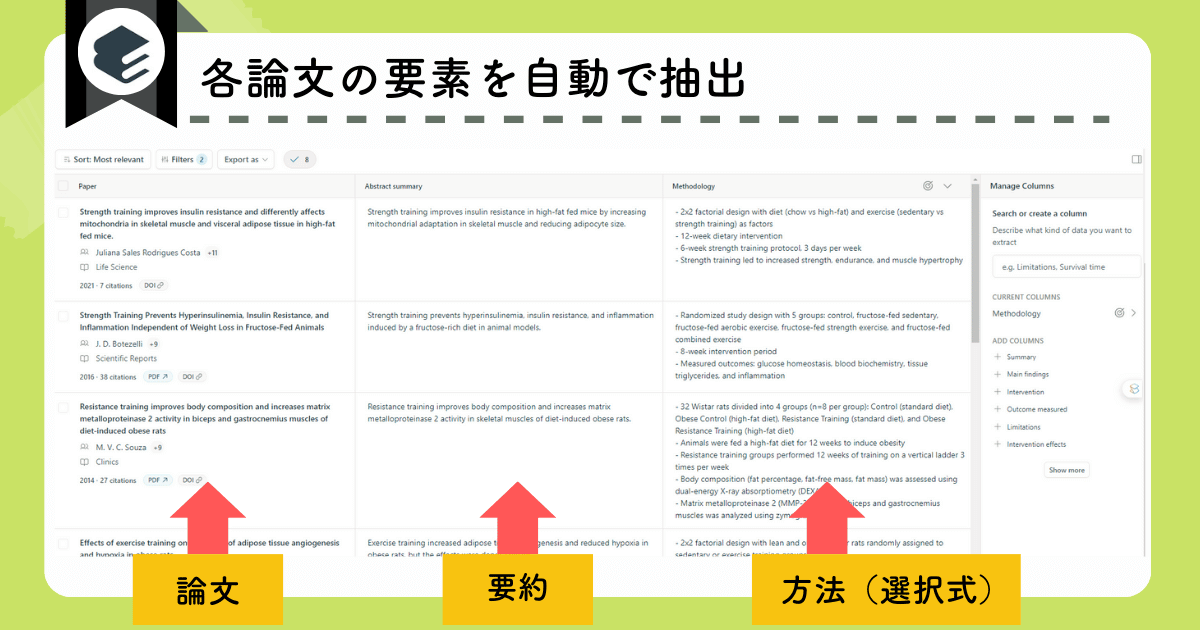
 Akanon
AkanonThe specifications in this area are the same as for SciSpace.
What makes this table superior to SciSpace?
Clicking on an extracted sentence will take you to the corresponding part of the text.Things to do.

If you turn on the high-precision mode of the paid plan, each sentence of the extracted text is numbered to allow you to check the quoted part in detail.
 Akanon
AkanonBe sure to set the high-precision mode for important items.
Elicitis a tool that you can continue to use even with a free plan.
What is the recommended timing for upgrading to a paid plan?When you want to increase the precision mode.
 Akanon
AkanonTry it first within the free range.
The following article also details the differences between the plans.
Official SiteElicit: Elicithttps://elicit.com/)
explanatory article:Thorough Explanation] What are the advantages of using Elicit and how much does it cost? A detailed explanation of the AI tool that streamlines the search for articles.
Create a complete review with systematic reviews.
In a nutshell, Elicit's systematic reviews are the main steps of a systematic review.AI fully automated, but with the ability for humans to adjust each step.It is.
 Akanon
AkanonThe key point is that users can modify it.
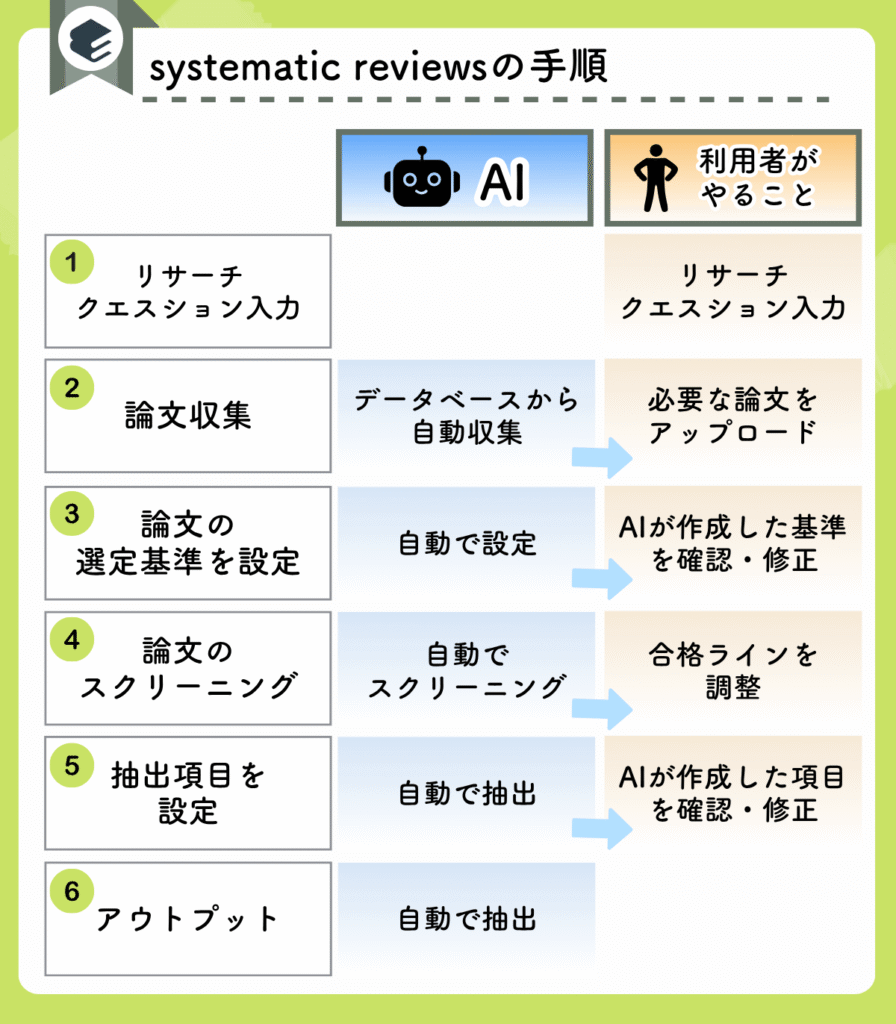
What kind of report will be completed...
Examples of actual reports



 Akanon
AkanonA comprehensive review prepared with reliable procedures in a single stroke.
Frankly, the performance far exceeded our expectations.
Consensus when you want to find quality papers for important occasions.

consensuss literature search functionality is on the verge of surpassing that of SciSpace and Elicit.
What Consensus literature search can do for you
- Enter your search in the form of a sentence (questions that can be answered with Yes/No are especially recommended)
- A summary with citations is displayed for the search.
- Sort papers by the labels in the search results.
- Re-search with filtering at will
Three Question methods are recommended for quality article searches
Consensus is a ”good (quality)”It has a reputation for screening and displaying papers.
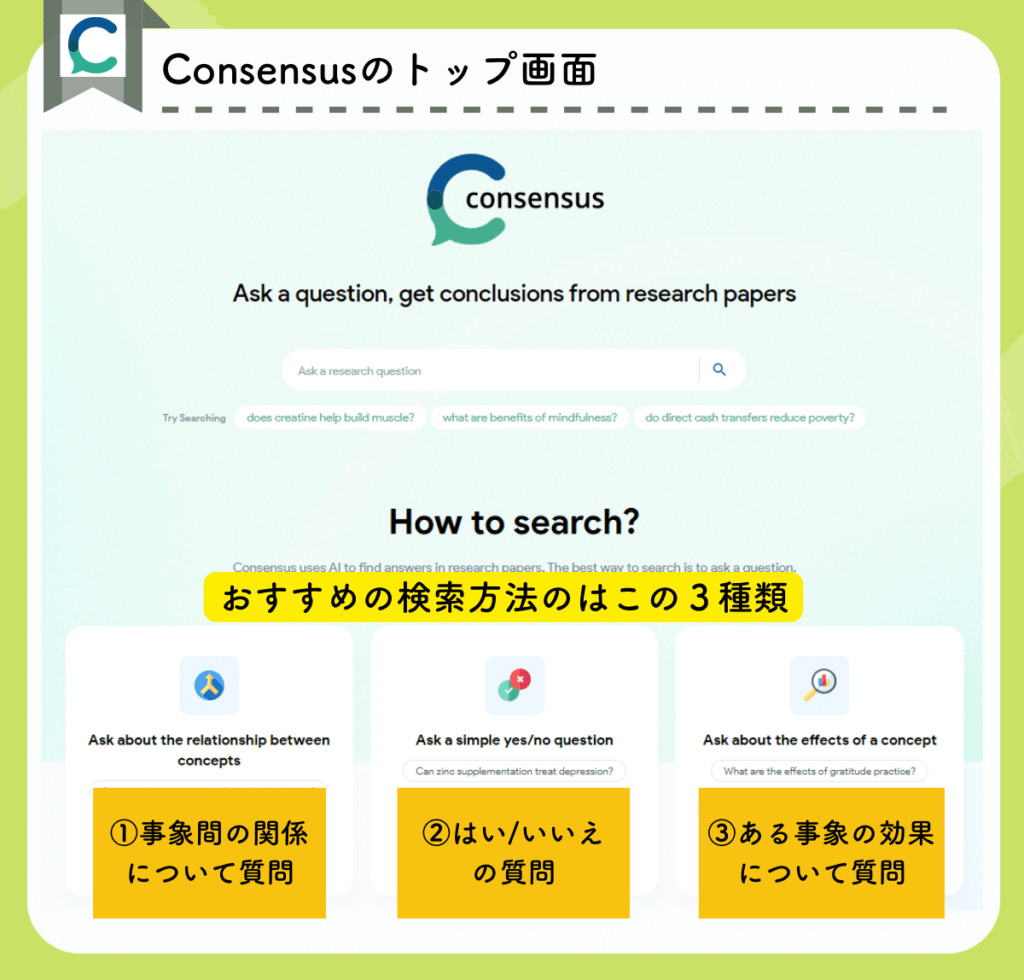
Consensus specifies its recommended search method in this way.
- Questions about relationships between events
(e.g., "Does creatine improve cognition?") - Questions that can be answered with "yes/no
(e.g., "Can zinc supplements help depression?" - Question about the effect of an event
(e.g., "What is the impact of immigration on the economy?")
The author recommends (2)Questions that can be answered with "yes/noSearch by.
 Akanon
AkanonFor example, let's throw out a question like this as appropriate.
Does Creatine Improve Muscle Strength?"
Outputs include Summary and Consensus Meter
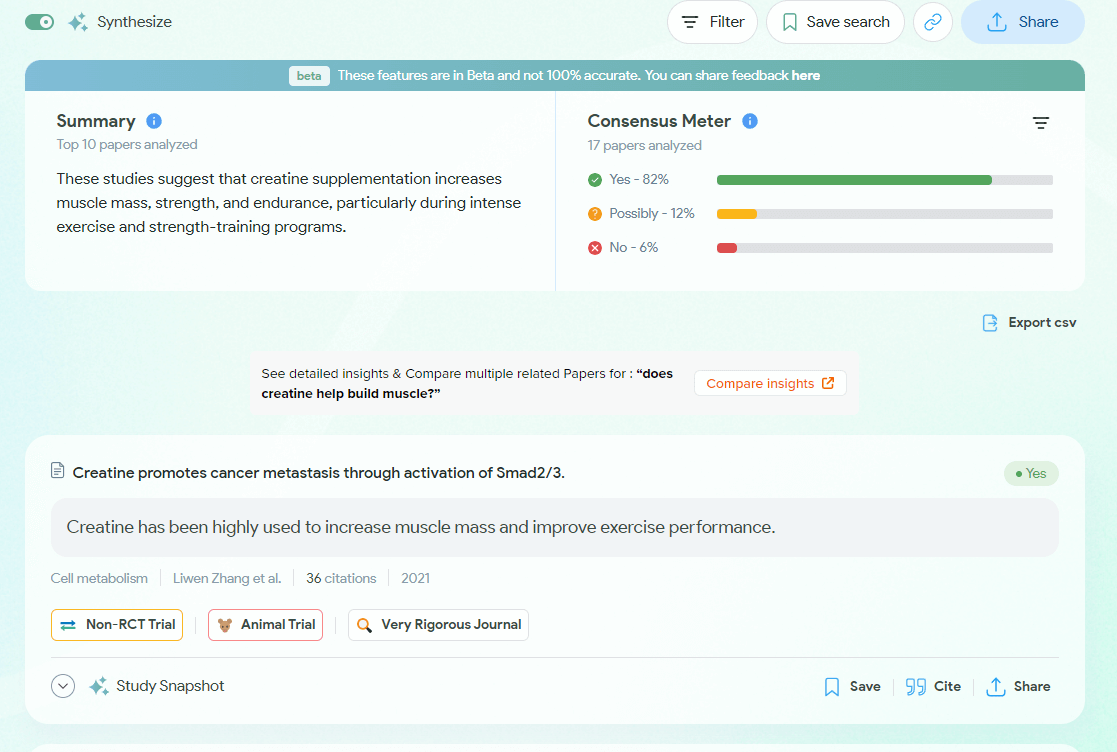
There is a summary in the upper left corner, Consensus Meter in the upper right corner, and search results for each paper below.
It is no longer standard in AI searches to come with a summary.
Here is something very novel,Consensus MeterThis is the one and only function that
It aggregates the results of the top papers and produces a graph like this one.

It's amazing...
When entering a new field, building a new experimental system, etc.
What is the prevailing opinion on this question?"
The question "What is the best way to do this?" is answered in one shot!
Extensive labels make the research easy to understand at a glance
Other very good points are that Consensus has a very rich labeling function and the search screen makes it easy to see the quality and overview of the research.
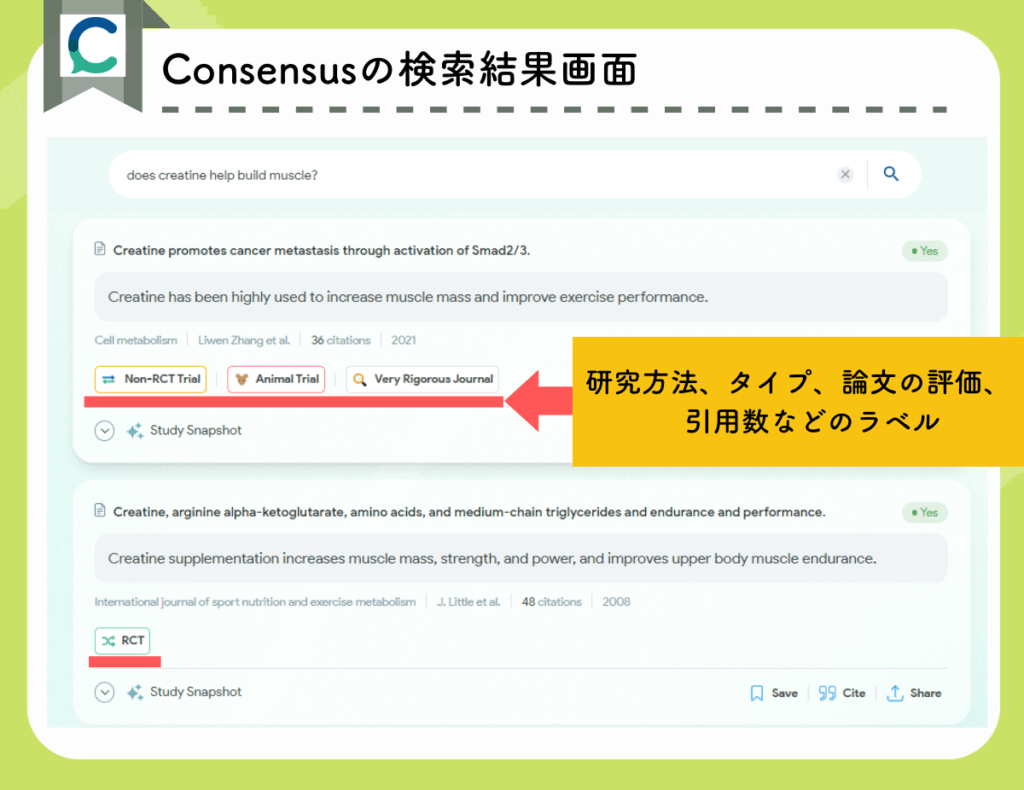
Label type
- Research Assessment:Rigorous Journal, Very Rigorous Journal.
- Number of citations:Highly Cited.
- Study Design:RCT," "Non-RCT Trial," "Case Report."(lessening the significance or value of the previous word) the likes of
- Clinical or basic research?Animal Trial.(lessening the significance or value of the previous word) the likes of
This label makes it very easy to find papers.
Easy-to-use filter functions
In addition, Consensus is easy to use with its filtering capabilities.
An example is shown in the figure below.
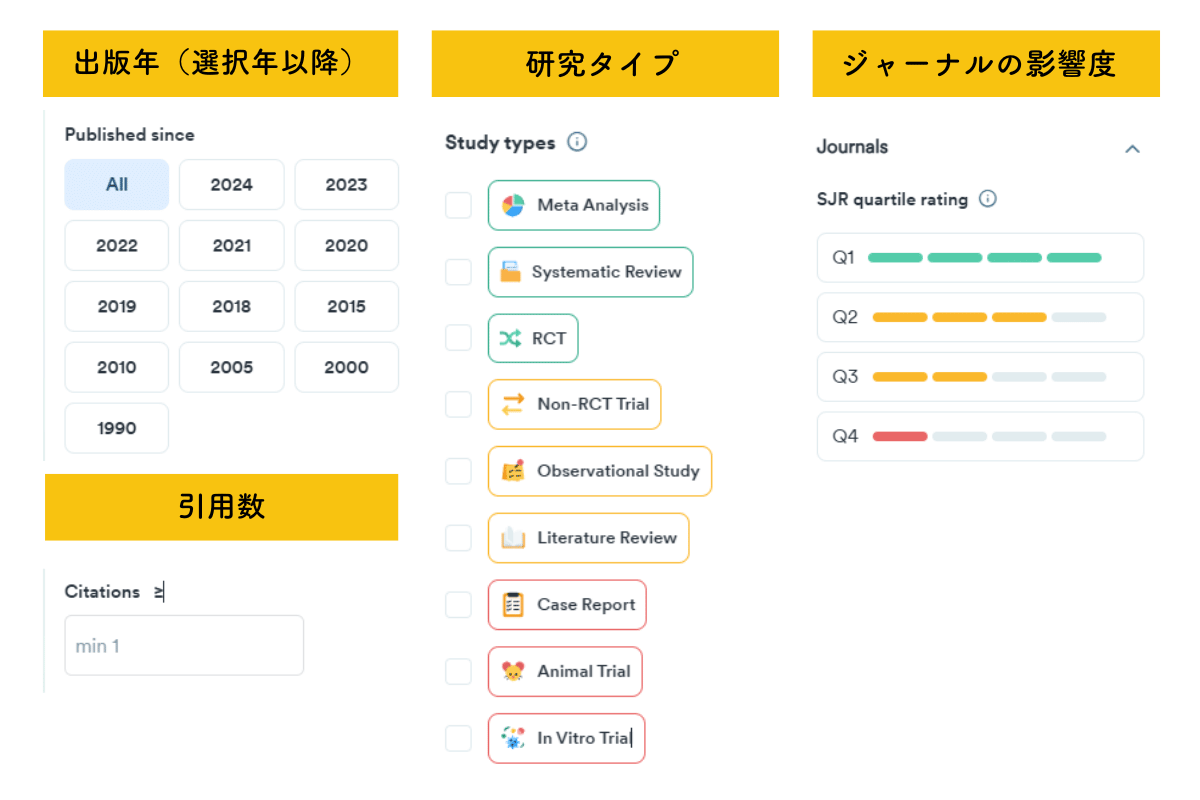
Make great use of this filter function to narrow down your thesis.
You will always find the best paper that says "This is it! You will always find the best paper that says, "This is it!
consensusis available free of charge but with quality AI.
However, there is a limit to the number of times it can be used.
If you actually try to use the service and are inevitably caught by the frequency limit, please consider switching to the paid version.
Monthly rates start at $8.99. Limited time offers and student discounts are also available.
 Akanon
AkanonSo far I am using it within the scope of the free version.
For more information.
Official SiteConsensus: Consensus (https://consensus.app/search/)
explanatory article:https://www.academianote.site/consensus/
Connected papers for a deep dive into related papers

A literature search AI tool completely different from both SciSpace and Consensus, "Connected papers」!
This tool is really amazing.
- Network visualization of related literature
- The distance between circles indicates the depth of the relationship.
- The size of the circle indicates the number of citations
I'll dig up the paper from the references in the paper like a hot potato to make sure I don't leave out any citations."
What a daunting task it used to be!
Even after spending a considerable amount of time on it, I would sometimes omit citing important papers.
In modern times, Connected papers would be the coup de grace!
First, upload your paper from the top page.
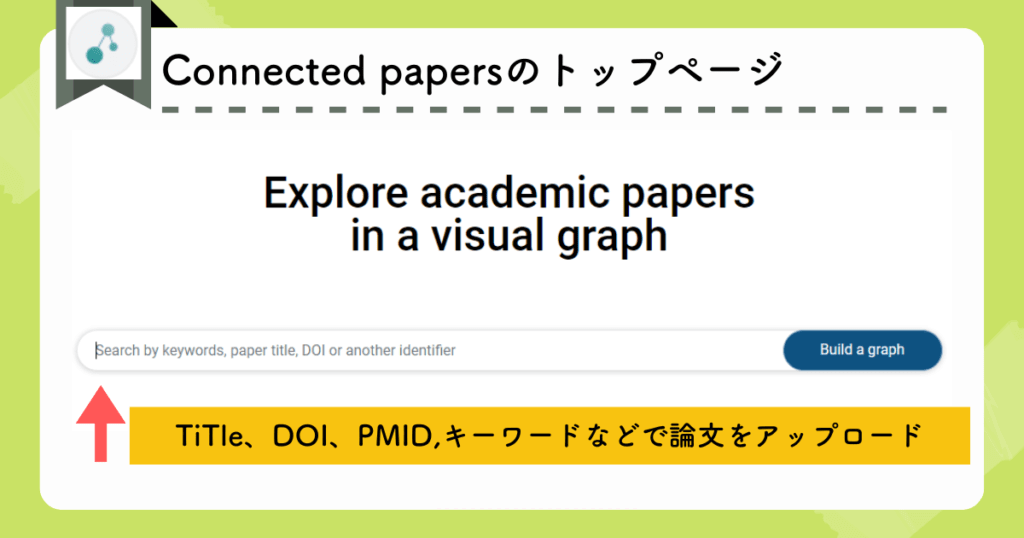
It provides a visualization of the original paper and other related papers.
The distance between the circles represents the depth of the relationship and the size of the circle represents the number of citations.
If I forgot to quote the larger circle, please check it out.

You can also list and view the details.

 Akanon
AkanonIt's also very similar to Research Rabbit.
Slightly different points are,Research Rabbitis where the distance between the circles has no meaning.
And with Connected papers, up to 5 graphs per month are free.
If you want to create more graphs than that, the annual plan costs less than 700 yen/month. (Check back from time to time as the exchange rate fluctuates.)
Official Site: Connected papers (https://www.connectedpapers.com/)
explanatory article:What are Connected Papers? Seven recommended features and pricing plans explained by an active researcher.
summary
In this issue, we summarize how to use this information to save time in literature searches!
Please take a look at our other articles on dissertation-related tools.
\Literature Search Tool/
 Akanon
AkanonThank you for reading to the end.
Article updates are also posted on X and Instagram.
Please follow us and check it out!
- click here
- Click here for the installation.
- Click here for YouTube (in preparation)
- Click here for NOTE

request
Thank you for taking the time to read this article.
This is a personal site that the operator updates little by little in between his personal life.
If you found the content of this site helpful,
We would be happy to receive feedback on social networking sites.
The feedback we receive will encourage us to create future articles.

